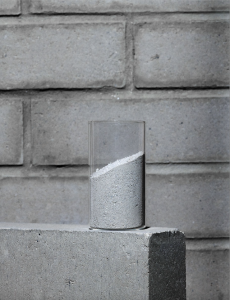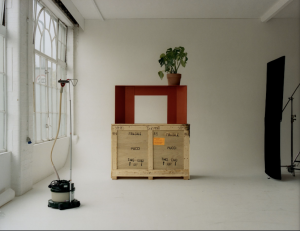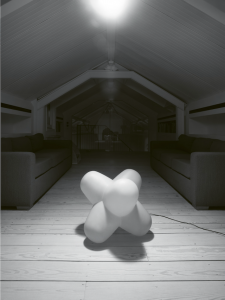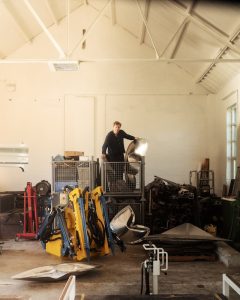Gus Casely-Hayford, director of the forthcoming V&A East in London, speaks to Tavares Strachan about his ambitious work, reflecting on the past, the politics of invisibility, and his recent exhibition at the Hayward Gallery
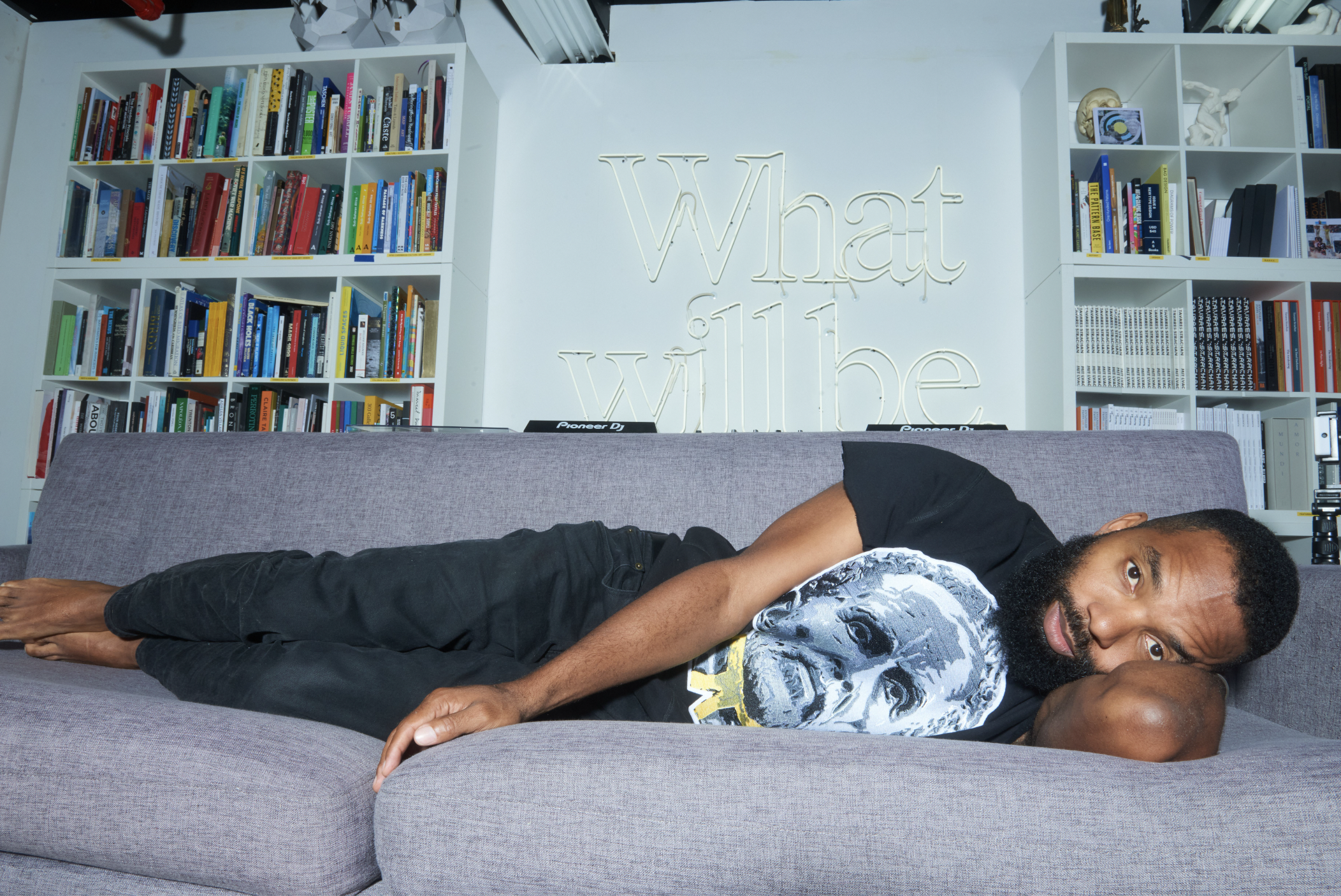
OK, imagine that I offered you an art pass – a pass that could allow you to travel to any moment during the last century, to be there for any culturally significant event of your choosing. Dinner with Matisse, Achebe? I can take care of it. Maybe tickets for Keith Jarrett’s Köln concert, or perhaps the final Elgar Cello Concerto of Jacqueline du Pré?
How would you use it? Perhaps you would be there for Miriam Makeba’s triumphant return to South Africa after the unravelling of Apartheid, or maybe join New York’s avant-garde at the legendary 1939 opening of Frida Kahlo’s inaugural exhibition at the Julien Levy Gallery? I might go to the opening of the 1937 World’s Fair in Paris, when Picasso unveiled Guernica – a vast canvas that graphically captured a moment of mass murder meted out upon a quiet Basque town, forging one of the most effective anti-fascist statements ever made. As women and children gathered in the central square on market day, between 170 and 300 civilians were eviscerated, vaporised by multiple aircrafts. It is a work that can suck the breath from your lungs.
And in an adjacent pavilion at that very same fair, the Norwegian artist, Hannah Ryggen, showed textiles of similar scale that made a similarly devastating impact. Ryggen focused on the Italian invasion of Ethiopia. In a series of extraordinary tapestries, she held an unforgiving mirror up to a Western world that had turned its back as a quarter of a million Ethiopian troops were slaughtered trying to defend their nation. Ryggen refused to let us forget that the world did nothing as 78,500 Ethiopian resistance fighters were killed during the occupation, as 17,800 Ethiopian women and children died in the bombing campaign, as 35,000 people lost their lives in concentration camps, as 24,000 men were executed after the war. When 300,000 civilians died in the aftermath, there was only a mild ripple of outrage, and little else. But then, there was Hannah Ryggen.
Two appalling acts and two utterly fearless creative responses to fascism. What must that have been like to witness? One of those rare, rare moments when art does not just reflect the ambient mood, it somehow becomes a prescient bellwether, it hints at things that are yet to come.
1937 might be a high bar, but I would argue that London, 2024, should be on our list too. 2024 has been a truly extraordinary year for the visual arts in London. In a year like 1937, when culture did not reflect our mood, it seemed to gallop ahead and shine a light for us to follow. Against a backdrop of global instability, of bitterly contested racialised-elections, of economic uncertainty, of populism and political polarisation – we were treated to some deeply affecting art. There was a moment over the summer in London when Yinka Shonibare’s exquisite Suspended States was at the Serpentine, The Time is Always Now had opened at the National Portrait Gallery, there was a James Baldwin season at the Barbican, Joy Labinjo bestrode the Camden Arts Centre, Zanele Muholi’s work graced Tate Modern, Ernest Cole at the Photographers Gallery, Nick Cave, Ghada Amer and Yinka Shonibare in Cork Street – and so it went on. Commercial, national, independent galleries were all celebrating artists of African descent. Not in a coordinated season, just a timely response of near ubiquitous programming: the British art establishment reflecting on long overdue questions of equity, race, identity and the legacies of empire. A moment when a whole sector simply said, we cannot continue to remain silent.
And amongst that astounding body of work spread across an unforgettable year, the practice of Tavares Strachan lingers in the mind. This is work that does that bigger thing of not just making us think, but encouraging us to dream. Strachan is an artist who understands history and emotional damage – he’s spent time not just mapping the past, but reflecting on how its shadow continues to corrupt and contaminate our world. And whilst his work is robust, disciplined, impactful – he somehow also gives us desperately needed comfort. He throws an arm around us. ‘We are in this together,’ encourages one neon text piece, while another states ‘You Belong Here’. And I believe him.
In February of 2024, the Royal Academy of Arts opened Entangled Pasts, Art, Colonialism and Change. In RA tradition, it was both a magnificent historical survey and formidable sweep of contemporary practice. But unusually for the institution, it was uncompromising in its confrontation of issues of empire, race, distorted narratives and pervasive legacies of that past. And as a greeting in the courtyard of Burlington House (a Neo-Palladian temple that houses the Royal Academy), in a spot that could be seen by anyone who walked or drove up Piccadilly, the curators sited Tavares Strachan’s The First Supper: an unforgettable reinterpretation of da Vinci’s enigmatic The Last Supper. In the The First Supper, an animated Haile Selassie sits in the space taken by da Vinci’s Christ – his disciples are Mary Seacole, Marcus Garvey, Harriet Tubman and other heroes and heroines of Black history – and the place of Judas is taken by Strachan himself. Life size, cast in bronze and finished in black and gilt, it is an astonishing object.
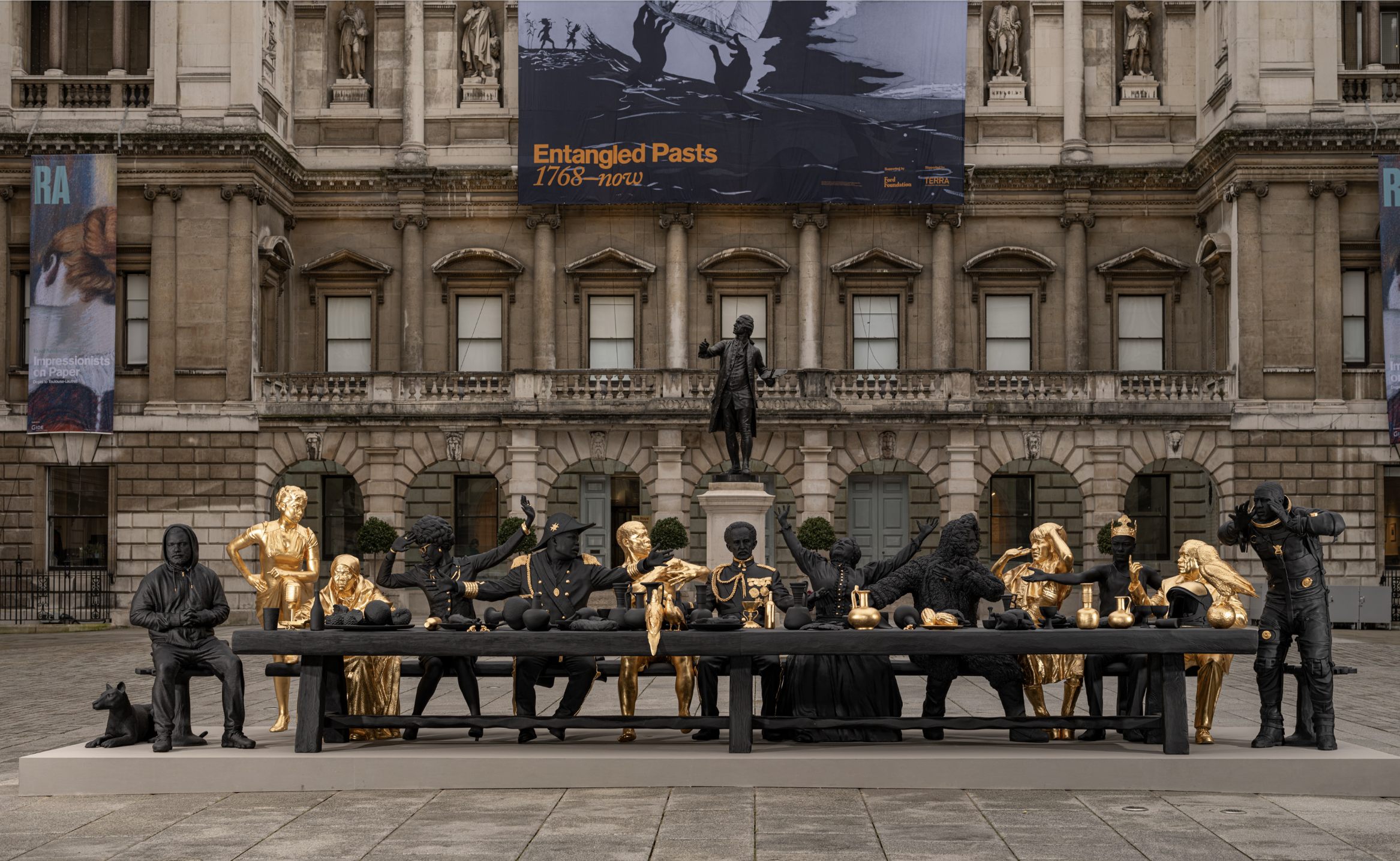
When I ask Tavares why he chose to take the seat as Judas in this tableau, his answer surprises me. “Judas was born to be a traitor,” he says. It was his destiny – and yet, he was forever blamed for playing a preordained role in fulfilling Christ’s purpose. Christ’s message was about his own sacrifice, but Judas also had to sacrifice himself for the Christian narrative to be tenable. “What choice did Judas have?” Strachan asks. “I like thinking about him as a kind of hero. Without him, the crucifixion and Christianity do not really happen.” And that was the moment when I fell for Strachan’s work. This is art for the rest of us. This is art for those whose destiny was not to end up on the plinth; it is for those whose histories were conventionally not taught in schools or celebrated in traditional libraries. This is an arm around your shoulder – You Belong Here.
Strachan is an unusual man. Although his work is a vivid map of contemporary concerns, he is, in so many ways, of another age. He is the sort of complete artist-intellectual who would have been successful in the 16th or 17th centuries. He has worked in varied creative media from lost-wax bronze casting to drawing, from video to photography, from installation to fashion, with artworks sitting at the fascinating intersection of art, science and technology. As he beautifully puts it, “I need to think poetically about the world, but I also need to think scientifically about the world.” He is interested in how things work as much as what they mean and how they look and is keen to deconstruct our understanding of the things we take for granted.

But he is also an uncompromising explorer. His curiosity has taken him to the Arctic four times, he has travelled to the North Pole, journeyed to the bottom of oceans and is one of a tiny number of people who have been trained to leave the orbit of the earth and travel beyond the pull of its gravity. He even founded scientific research platform BASEC (Bahamas Aerospace and Sea Exploration Center) to develop the technologies to further satisfy his appetite for tackling these old-new frontiers. And as you might guess with Strachan, even the equipment and accoutrements that he sourced and designed for these expeditions was utterly exquisite and covet-worthy. And so, in 2024 he began to retail his BASEC wear as a clothing line. In London, it is stocked by stores like Dover Street Market.
Perhaps, at heart, he is a figure of the 21st century – a cultural cartographer, a collector, interrogator and investigator of histories, someone who questions the systems and accepts axioms upon which we base our understanding of the world. He is unafraid to suggest beautiful alternatives and build the knowledge systems and narratives to respond to the most telling questions of identity, history and race. Strachan dedicated a decade to creating a vast leather-bound volume that shines a light on the overlooked and forgotten areas of knowledge. He called it The Encyclopedia of Invisibility. As he explains, “I think it just started off with a very simple question: if everything in the world had somewhere to go, then where were the things that didn’t have a place?” This is a kind of fascinating query, but once probed, how could you not want it to be answered? “And then I just thought, what if the project grew and grew and grew? I didn’t imagine it would get as big as it has. Now, we’re 3,000-plus pages and over 17,000-plus entries.” And, of course, it is spellbindingly beautiful.
Strachan is an indefatigable force, voraciously taking on new and complex projects that sometimes require new training and knowledge or might even incur great personal risk. But almost everything he engages with seems to deliver astonishing output. “I am always making,” Strachan says, “and I think that if I didn’t have those outlets, maybe some of that impetus to come up with stuff might manifest itself in [negative outcomes for] my mental health. So, I will just keep making things up, even though there’s nothing to make up.” And perhaps that empathic, beautiful, contagious drive is why one of Strachan’s great inspirations is Matthew Henson, the earliest Black Arctic explorer. As Tavares explains, Henson was a hero, an “avid sailor and an explorer. And this was in 1909, which meant, in America, (as an African American) you’re on the brink of slavery. So embarking on these perilous endeavours set you within a treacherous framework.” Henson possessed an odd, almost supernatural drive to take on marathon-scale things. He began life as a cabin boy but is thought by many to have crossed Greenland and reached the North Pole. Understandably, Henson is one of the guests invited to join the pantheon of Black heroes in Strachan’s The First Supper scene. Henson takes a seat to the left of Haile Selassie, visually connected to the figure that is based upon Strachan at the top of the table. They both wear hoods and face in opposite directions, linked by symmetry and spirit.

Whilst Tavares might need to create, in a world on fire, I think we also need Strachan. When Derek Chauvin knelt upon George Floyd’s neck, there was confidence with which he did so – the desire to ensure Floyd’s complete supplication and utter silence, even beyond the moment when George stopped asking to stand up, beyond the stage when he ceased pleading for a breath, beyond that heart-chilling moment when he called for his mother, beyond the point when George’s body let go, the knee remained. That pathological confidence was based upon a deep, hard, bedrock of prejudice that will require profound effort to challenge. Perhaps the reason that Chauvin was so assured in his actions was because he felt he was acting on our behalf. And what do we do in the face of that? Well, Strachan offers us a beautifully crafted conceptual corrective toolbox with the power to engender pride, to furnish us with missing histories and omitted context, and to perhaps make us feel a little braver in the face of the ambient craziness. “I’m just so elated to be an artist making artwork at a time when we’re saying, ‘Enough of that bullshit,’” he says. “I am making work that creates a new kind of proposal, that is reflective of the kinds of experiences that people living in a non-western reality are constantly living.”
Strachan was born in the Bahamas in 1979. “I was raised by a lot of Rastas,” he tells me, “and for us the Western world does not have the authority to steal any history. Every art form over the last 200 years has been created as the result of something being taken away. And the universe then gives these groups the tools to create new art forms.” The Bahamas is one of the most beautiful parts of the world, but as Tavares acknowledges, “I am coming from a place where there was this kind of desert, this emptiness of resource.” And anyone who has visited the Bahamas will understand what he means. The Bahamas is naturally blessed, but not a place that has a space programme or an exploration centre. Tavares was, from a young age, deeply determined to use whatever means he could to acquire the skills, tools and gain the experience that he craved.
It felt right that in this particular auspicious year of global climacteric that the Hayward Gallery would dedicate an exhibition to Strachan; three floors that included his monumental heads, galleries of terracotta, his vast encyclopaedia and delicate neon signs. There is Light Somewhere is an extraordinary mid-career statement; it traverses and deconstructs art history, with work inspired by ancient cultures, by vast empires and the migration of millions. “I think we’ve exhausted the ideology of modernism,” says Strachan. The reactions to the exhibition have been extraordinary. As Strachan tells me, “I was dumbfounded by the number of people who were in tears, because as someone making the work behind the curtain, I think to a certain extent, I’m a little bit desensitised to the kind of emotional punch that the work may deliver.” As you climb the last few stairs onto the top floor of the Hayward Gallery exhibition, the space opens up and out. And after the intense, almost domestic intimacy of smaller spaces beneath, suddenly you feel like an explorer, cresting a mountain through clouds. You wander amongst a pantheon of ceramic afroed deities, there is daylight and the rooftops and the distant London skyline. It allows for an exhalation of breath, before the wind is again sucked from your lungs by another incongruously beautiful thing. On the balcony outside the gallery, there’s a large-scale model of a ship silhouetted against the sky; a replica of the SS Yarmouth, the flagship of Marcus Garvey’s Black Star Line (a Black-owned shipping line that was founded after the First World War). “You know, we talk a lot about how society needs to change, right?” exclaims Tavares, before I say goodbye. “It’s not just about society itself needing to change. I think the framework by which we judge, manage and imagine society also needs to change. I think that putting the boat on the roof is just a way to offer an unexpected narrative.” That is impossible to argue with. 2024 was a year when artists spoke with great eloquence of deeply acculturated and embedded patterns of problematic thinking, but they also found ways of getting so many of us to look up and out – and perhaps to set sail for new horizons.
Photography Davey Adésida
This article is taken from Port Issue 35. To continue reading, buy the issue or subscribe here
